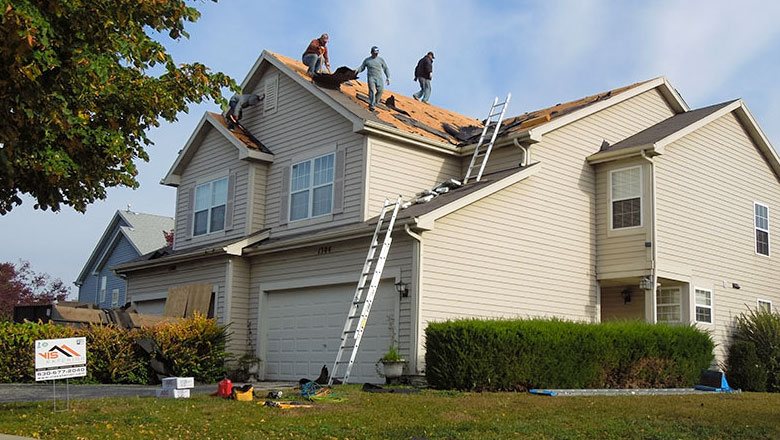How to Spot Hail & Wind Damage on Your Roof and Siding (How Much Does a Repair Cost)
As a Midwesterner, you have seen your share of hailstorms, and so has your roof and siding. You might also have an idea of how to spot hail damage. Unfortunately, not all damage can be seen from the ground, or even on the roof if you don’t know what to look for. At VIS Exterior, we know how to spot hail damage on a roof and on siding, because it’s something we’ve been doing for two decades.
Hail damage on roofing and siding varies from almost insignificant to so severe that the entire surface area is damaged and needs to be replaced. Therefore, the cost of repairs and replacement of roofing and siding will also vary depending on the severity and the size of the home.
Hail less than an inch in diameter can cause damage to your roof and siding. While larger hailstones leave obvious damage in their wake, the smaller stuff might not seem that bad in comparison, but as a hail damage house inspection expert, VIS Exterior knows where to look for the more subtle damages that can lead to big problems later.
Table of contents:
- FACTORS THAT INFLUENCE HAIL AND WIND DAMAGE
- WHAT DOES HAIL AND STORM DAMAGE LOOK LIKE ON A ROOF?
- COMMON SIGNS OF HAIL AND WIND DAMAGED SIDING
- HOW TO CHECK FOR HAIL DAMAGE ON ROOF AND SIDING?
- WHAT TO DO AFTER A HAILSTORM?
- REPAIR OR REPLACE YOUR ROOF AFTER HAIL & WIND DAMAGE?
- REPAIR OR REPLACE YOUR SIDING AFTER HAIL & WIND DAMAGE?
- HONEST AND FREE ROOF AND SIDING INSPECTION
- HOW MUCH DOES HAIL DAMAGED HOUSE REPAIR COST?
Factors that influence hail and wind damage
Hail damage is much more severe with accompanying high winds. Siding damage from wind and hail, as well as damage to the roof, requires the attention of a qualified roofing and siding contractor with experience inspecting, repairing and replacing damaged areas. The following are some important components associated with roof hail damage and siding damage:
Size of the hailstones
Any hailstone .75 in. and larger can damage your roof and siding. Coupled with high winds, hail damage and wind damage can drastically shorten the lifespan of your siding and roofing.
Wind speed
Most thunderstorms that create hail are accompanied by high winds, which can create gusts that make the impact of hail on your roof and siding much more damaging.
Unobstructed access
Homes that get hit the hardest by hailstorms are those that have no trees or other wind barriers shielding them. Without these barriers, the wind and hail are free to pummel your home with maximum effect.
Hardly any roof is completely sheltered to the risks brought by high winds and hail. Debris whipping around in the air will eventually find your roof and perhaps even your siding. Whether it’s one huge storm or years of abuse from smaller ones, contact us at VIS Exterior and schedule your inspection today.
How to identify hail damage to your roof and siding
There are two key factors in how hailstorms damage roofs and siding: hailstone size and wind speed. While hailstones on the larger scale don’t require much wind to do damage, small hailstones propelled by extremely high winds can cause more destruction than larger stones at low wind speeds. To know how to identify hail damage on your roof, look for impact damage from the ground, which is a safe place for homeowners to survey the storm’s severity. You can do the same with your siding.
Knowing which direction the wind was blowing during the storm can help you find potential problem areas. For example, if the wind was blowing from the southwest and you’re looking to identify hail damage to siding, you will likely find damage to southwest-facing surfaces, which bear the brunt of those winds.
What does hail and storm damage look like on a roof?
What does hail damage look like on a roof? In many cases, pock marks on asphalt shingles will look like dark splotches from the ground. This is likely because the underlying segments of shingles are black and are being revealed. With cedar shake or shingles, you’ll notice cracking or dents and perhaps even missing shingles in the worst-case-scenarios. If damage is visible from the ground, you definitely need to call in a roofing contractor to inspect the extent of the damages.

It is not uncommon that when there is no visible damage from the ground, it’s there but unnoticeable without closer examination. When the wind fluctuates during the storm, some gusts can cause impact damage from debris, whether it’s hail or other type of debris. However, high wind gusts alone can lift shingles and displace them, allowing moisture to creep in. This is the reason that after a big storm, regardless of whether you see damage, you should schedule an inspection, because small problems now can lead to major problems later.
Hailstorm roof damage can vary greatly depending on the storm, the type of roof material on your roof and the age of your roofing system. For instance, an older roof might experience greater damage from a storm that causes little to no damage on a new roof. To ensure your roofing system is fully functional, contact VIS Exterior and schedule an inspection.
Signs of hail damage on an asphalt shingle roof
Identifying hail damage on shingles ranges between easy and nearly impossible for the average homeowner. When a massive hailstorm strikes, you’ll see foliage stripped bare, dents in cars and plenty of other landscaping wreckage. When you see this, you can be fairly confident the asphalt shingle roof has taken a hit, too.
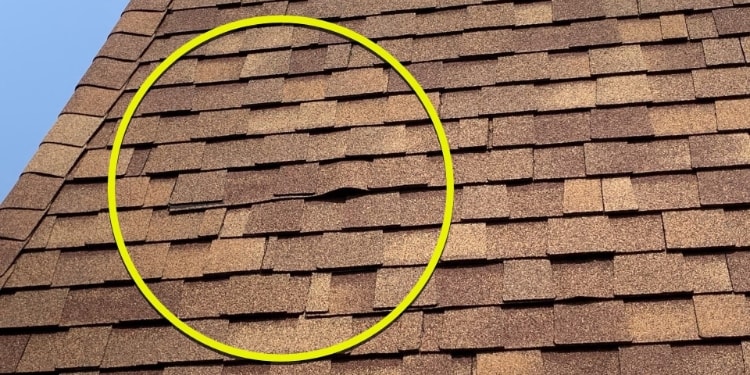
So, what does hail damage look like on shingles? In most cases, you’ll see small divots, black areas that are mostly round, bruising and perhaps even some missing shingles. Also, you should notice a collection of granules in your gutters and downspouts. Granules are the outermost protective layer of the shingle that have been knocked off, making the shingles vulnerable to further damage later.
Asphalt shingles made today are durable. They not only take a great deal of punishment from hail, but also hold up to extreme temperature fluctuations, snow, ice and rain. But as asphalt shingles age, they lose their protective granules and eventually become less able to stand up to the storms that were once barely a threat.
It’s important to mention that not all damage is going to be visible from the ground. Some shingles will split on the backside, which will not be noticed unless you call in a roofing contractor to lift some of the shingles to get a closer look. Furthermore, the contractor will also examine other areas of the roofing system that are important in protecting your home, including roof vents, skylights, gutter, flashing and chimney caps and covers.
Some roofing systems are more at risk than others, including the following:
Cracked or missing shingles
Beginning with the most obvious is a missing shingle, which is a sure sign that other areas of the roof are in jeopardy, or cracked shingles, which means moisture is surely going to find its way into your interiors. Either situation calls for immediate assistance from a professional roofing contractor.
Damaged or missing flashing
Flashing is an important component of the roofing system because it helps direct water away from your roof and into the gutters where it can be carried off by the downspouts. When flashing is damaged or missing, not only is the water not directed away from the home, it’s also at risk for getting under shingles and into the home.
Dark spots
If you see a dark spot on your shingles, you’re seeing the black asphalt layer beneath the outer layer. Older roofs will show dark spots more often than new roofs, because old roofs have lost their protective qualities and are more prone to damaging impact of hail and other debris.
Granule buildup
Protective granules on the outermost layer of the shingle are the first line of defense on your roofing system. Hail and other windblown debris will knock these off, often collecting in gutters and downspouts. When too many of these are missing, hail damage can occur more easily and with greater frequency.
Dented penetrations
The next worst damage after cracked or missing shingles are dented penetrations. When hail hits the roof at great speed and/or is of a larger size, the denting can actually lead to penetration of the surface of the shingle. Any moisture that hits the roof from then on will likely lead to interior water damage.
Asphalt shingles are the most popular roofing material on the market, and while manufacturers are making them more durable than ever, they are still at risk of failure in windstorms involving hail. Even if you don’t see the signs of damage listed above, you should err on the safe side and have your roof inspected, especially if it is getting on in years. VIS Exterior has you covered by offering free hailstorm roof damage inspections.
Signs of hail damage on a wood shingle roof
Identifying hail damage on wood shingles begins with a survey of the roof from the ground. While cedar is known for its ability to withstand impact, it’s not able to hold up to the most punishing hailstorms. So, what does hail damage look like on wood shake shingles? Look for the following:
Small indents
The most common flaws you’ll see following a big storm involving hail are small indents. Most of the damaging hail will be around .75 in. or larger in diameter, which means you need to look for indents around the size of a pea.
Breaking and holes
A step up from the denting damage is breakage and holes. What makes these more damaging is that they aren’t often seen, as the holes can be quite small and only visible to trained professionals who know what to look for. They can lead to insect infestations, water damage, mold and mildew.
Cracking
Roofing professionals most often see cracking at the midway point between ridges and valleys of the roofing system. They look like half-circle cracks, but regardless of their shape, they allow moisture to get into the underlying features of the roofing system where damage can go unnoticed for quite some time.
While hail damage to cedar shake roofs is one of the more common reasons homeowners contact roofing contractors, there are other types of damage that should also be part of the regular maintenance schedule. Ultra violet rays from the sun can cause damage over the lifespan of the roof, as can extreme hot and cold temperatures. To ensure your cedar roof is performing at its best, call in VIS Exterior for a closer examination.
Common signs of hail and wind damaged siding
When big windstorms sweep through the area, hail damage on vinyl siding is often the result. Vinyl isn’t the only siding material type that is affected; wooding siding hail damage is also prevalent. While wood siding is resistant to impact, cedar siding hail damage occurs when the storms are severe enough, the hail large enough and if the wood is nearing the end of its expected lifespan.
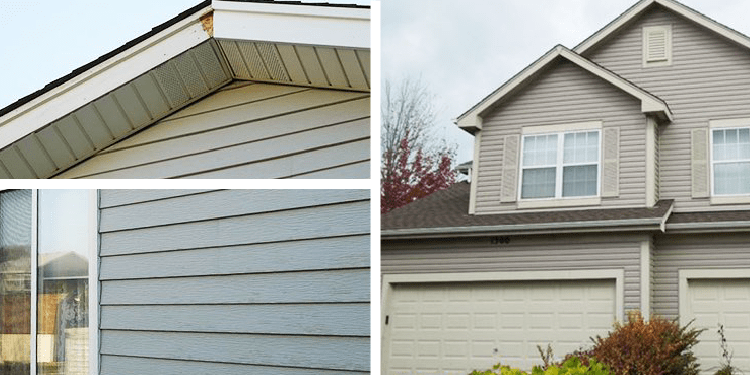
In some situations the storm will not be severe enough to cause obvious damage, but it might still be there. Hail damage siding events that occur over time result in subtle problem areas that need to be addressed and the only way to do that is through a thorough inspection by a siding contractor with years of experience investigating hail damage. If you notice hail damage to siding but think it’s only a cosmetic issue that you can deal with, be mindful that any visible damage is a sign that the home could be at risk for further moisture damage beneath the siding.
Just like your roof protects your interiors, so too does your siding. Whether the material is made of vinyl or wood, it can add curb appeal to your home, but it’s best quality is that it protects your home from the elements. To ensure your siding is fully protecting you and your family, contact VIS Exterior and schedule an inspection. We can make minor repairs that left unattended can lead to major issues.
Hail damage on vinyl siding
Vinyl siding manufacturers have made significant improvements in the way they make siding today. Not only does it come in a variety of colors, shapes and sizes, it’s also resistant to UV rays and is far more durable than vinyl siding of yesteryear. However, even the toughest, most durable vinyl siding can’t hold up to the most punishing storms involving hail.
Following a hailstorm, look at all sides of your home for damage, but pay particular attention to the sides of the home that were in the path of the storm. Look for dents, chipping, cracking or peeling paint. Any such signs mean your siding might not protect your home from future weather events.
Hail damage on wood siding
Apart from its unique aesthetic, wood siding is prized for its durability. When properly maintained, wood siding has a longer lifespan than vinyl siding, but that doesn’t mean it is impervious to hail damage. The most common visual clue that damage has occurred comes in the form of dents.
In some cases, cracks will be noticeable, as oxidized wood beneath the exterior will be visible. You’ll find that in most situations, damaged areas should appear darker than the siding that has not been damaged. Not all damage will be visible. For example, hail impact can cause tiny holes to occur, allowing moisture to sneak in and slowly do damage.
When you partner with VIS Exterior, regardless of whether you have vinyl or wood siding, we can help you find the damage and come up with a plan to repair or replace your siding. We work with the best siding product manufacturers to provide our clients with high-end materials that don’t come at a premium cost. Contact us today and schedule your free hail damage inspection.
How to check for hail damage on roof and siding?
Most homeowners aren’t exactly sure how to check for hail damage on a roof, but a quick and easy hail damage inspection can be performed by any homeowner. Following a storm where hail is present, you can visually inspect your roof and siding from the ground, looking for obvious signs of damage, such as dents, cracking, missing materials, chipped paint, etc.
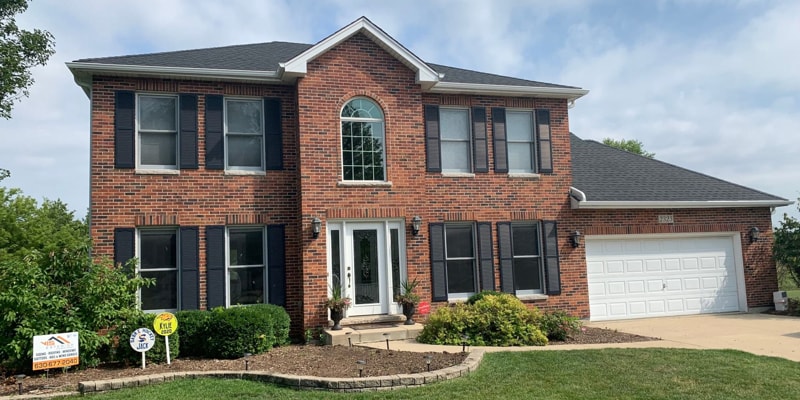
Look for misplaced shingles or siding. In the most severe cases, material will be completely missing. A hail damage inspection from the ground, while important, doesn’t reveal the more subtle damages that can only be diagnosed by a professional roofing and siding contractor.
At VIS Exterior, we’ll inspect the entire roofing and siding system, from gutters to downspouts, flashing to roof vents, skylights to chimney caps. These are all areas that can lead to leaks when damaged, so even if the flaws are minor and not noticeable from the ground, we’ll be able to seek them out and make the necessary repairs so your home is safe and secure.
Ignoring hail and wind damage? How it can progress
It can be easy to ignore wind and hail damage, particularly if the aesthetics of the home are seemingly perfectly fine from the street or yard. It’s not unusual for a hail damaged home to remain completely unnoticed for months and months, at which point the slow moisture leaks can cause everything from mold and mildew to wood rot.
You might notice your utility bills going up in the winter, as hail-damaged roofs will let warm air out. The same is true of hail-damaged siding. Pests can also become an issue with damaged siding and roofing, particularly wood siding and roofing materials. A routine maintenance schedule can help you avoid these problems.
What to do after a hailstorm: call a hail damage contractor or the insurance company for inspection first?
There are an average of four hailstorms per year in the Midwesterner, which means there’s a good chance that you rarely have to think about what to do after one of these storms. For some homeowners, their first thought is that they pay an insurance premium every month, so they call their insurance agent first. At VIS Exterior, we know the best option is to call for an inspection before you initiate an insurance claim.
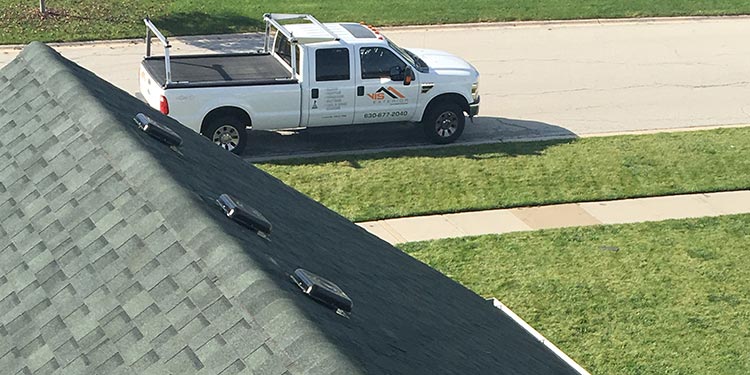
We offer a free consultation following storms that cause hail damage, so there is no risk of bringing us out to assist. After taking the initial steps of surveying the damage from the ground, your next step should be to contact us. We’ll take our findings directly to the insurance company and make sure everything you should be covered for in your policy is indeed covered.
From your roof to your siding, when a big storm comes through, we’ll look over the entire surface area of your home and seek out even the tiniest damages. Should your home require repair or replacement of either the siding or the roofing, we’ll meet your insurance adjustor when they do their inspection to ensure they’re seeing everything we found. With VIS Exterior on your side, you skip all the stress and leave the steps in the process up to us.
Should you repair or replace your roof after hail and wind damage?
Fortunately, not all hail and wind damage leads to a complete replacement of your roof. The technical term for a roof that needs repair is “functional damage.” This means that while it doesn’t require replacement, unless repairs are made, the lifespan of the roof will be compromised.
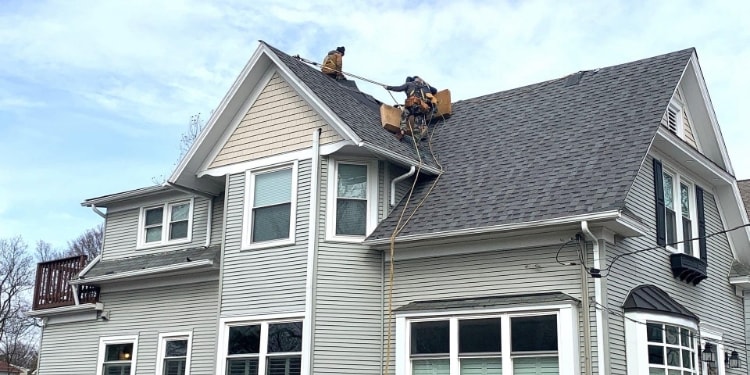
When caught early, VIS Exterior makes the necessary hail-damaged roof repairs that would otherwise lead to bigger issues, perhaps even a full roof replacement. We often have customers ask “do I need to replace my roof after a hailstorm?” and in many cases, we’re able to assist them with repairs rather than a replacement.
What we have found is that after years and years of exposure to the elements, older roofs become prime candidates for replacement, as wind and hail damage roof repairs add up and eventually do little to protect the roof from further damage. In these cases, it makes better financial sense to take on a full replacement.
There is no guesswork involved when you bring VIS Exterior in to handle your inspection. We can determine whether or not a full replacement is necessary now or if it can be put off for several more years. We only do what’s best for our customers, so rest assured that when you bring us in to assist, you’re partnering with a contractor that has your interests at heart.
Consider repairing or replacing your siding after hail and wind damage
Making repairs is a lower-cost alternative to a full replacement of your siding, but repairs aren’t always the best choice. For example, if your siding is older and has received extensive damage, rather than paying for repairs now and a full-on siding replacement job in the next few years, it makes better sense to choose hail damage siding replacement now.
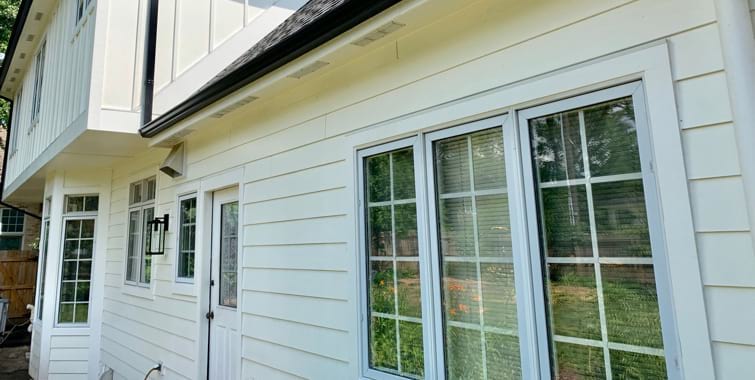
Whether it is wind damage siding repair or replacement or hail damage siding repair or replacement, VIS Exterior is the local siding contractor to help you determine the best option. We’ve worked with clients in DuPage County for two decades, assisting them with hail and wind damage inspections and plotting the best course of action moving forward.
Part of the process is determining the extent of the damage against the age of the siding, because if the siding is fairly new, making repairs might be the best option, as the undamaged portions of the siding have many years of life left in them. In either situation, repair or replacement, we lay out all the numbers and scenarios so our clients have all the information they need to make the best decision.
Honest and free roof and siding inspection with no further obligation
If you’re skeptical about getting an honest and free hail damage inspection, we understand your trepidation. In fact, VIS Exterior has worked against that issue since we were founded two decades ago and have established trust in all of our customers. Hail damage roof and siding inspections are provided to our clients free of charge, but that doesn’t mean you’re getting discount services. We see the inspection as our chance to impress upon you the caliber of contractor we are, as we clearly communicate our findings and our recommendations moving forward.
Don’t just take our word for it – see what our customers have to say about our services. We’re also an A+ rated contractor with the Better Business Bureau. But rather than rest on the laurels, we continue to provide the best possible siding inspection and roof inspection services, exceeding expectations and further strengthening our reputation as a skilled and trusted contractor.
Hail & Storm Damage Repair Services:
- Free thorough roof and siding inspection for damages.
- Free estimates for all recommended repairs.
- We deal with an insurance company so get you an honest assessment.
- Prompt, expert repair or replacement of storm-damaged elements.
How much does hail-damaged house repair cost?
The cost of repairing a hail-damaged house varies greatly, as some damages are extremely minor and can be fixed in minutes, while others can take an entire day or longer, depending on the situation. In aggregate, the average repair would be around $550, but again, the price can vary depending on each unique situation.
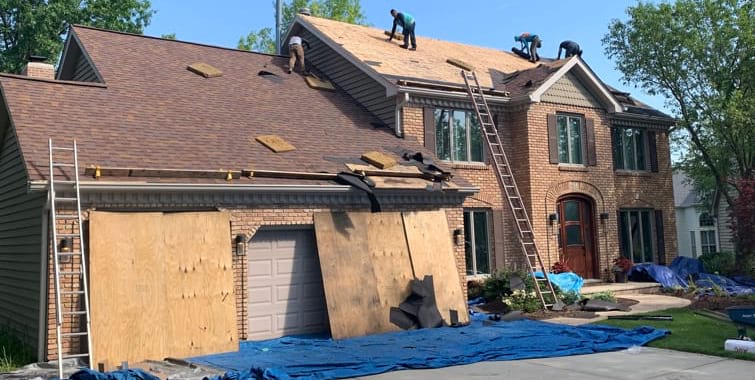
Hail-damaged roof repair cost
It’s easier to establish hail damage house roof repair costs, as these projects tend to be more consistent in their scope. Having said that, nationwide, the cost for roof repair is between $5,500 and $10,000.
You’ll find yourself on the lower end of that scale if your home is smaller and easy for roofers to navigate. For larger homes with more features, such as skylights, roof vents, etc., and a steeper grade, you’ll find those homes to be closer to the higher end of the average.
Hail-damaged siding repair cost
Similarly, siding averages between $6,150 and $15,900 for vinyl siding and between $7,000 and $23,000 for wood. Engineered wood and fiber cement wood, which are also popular siding options, can also range between $5,400 and $20,000 on a home ranging between 1,500 and 2,000 square feet. Again, the smaller and less complex the project, the less expensive it will be.
Cost is a huge factor when it comes to hail-damaged home repair services. Everyone has a budget, but sometimes choosing the least expensive contractor comes at an unexpected expense of its own. At VIS Exterior, we provide premium services that are competitively priced, but not at a premium cost level.
The following graphic details some of the most important aspects to consider when determining costs.
- Roof size
- Materials used
- Code requirements (differs per municipality)
- Pitch (steep roofs take more time and materials)
- Type of application
- Location
- Obstacles, such as skylights, plumbing pipes, chimneys, etc.
Among the costliest aspects of a roofing project is labor. Often, roofing and siding contractors that offer low-cost services utilize unskilled laborers, who aren’t paid a very good wage. The results are often less than desirable. A quality contractor uses skilled laborers who know what they’re doing and provide premium services, which is of value to any homeowner expecting quality results.
Labor costs can be impacted by the complexities of the roof. For example, the more obstacles present requires more effort to work around. The same is true of steep roofs, which require added safety measures and take more time.
Materials are also an important factor related to costs. While some homeowners prefer the aesthetic of asphalt shingles, they are also among the most affordable roofing materials, which lends to its popularity. By contrast cedar shake/shingles can cost up to six times as much as asphalt shingles, so if real wood is on the want list, the budget must make allowances for the added expense.
At VIS Exterior, we estimate that the average repair job to a roof is around $550. Some situations call for barely any repairs, which means the cost will be far less than the average. However, some hail damage requires extensive repairs and will run higher than the average cost for repairs. VIS Exterior will help you determine if it makes better financial sense to make repairs or do a full replacement.
Take advantage of our great financing offers
NO payment
NO interest
Get 0% interest for 12 months
Got hail or wind-damaged roof and siding? Call a professional storm damage repair contractor
Calling on trusted storm damage repair contractors is the best option for tackling your roof and siding issues quickly and efficiently. At VIS Exterior, we’ve assisted many, many homeowners with hail damage roof issues, as well as hail damage siding problems. The approach we take to assisting our customers has helped to establish a mighty reputation as the go-to contractor for managing hail damage to homes.
VIS Exterior will never sign on to a project that we know we can’t excel at. In fact, we always finish our siding and roofing jobs on time and on budget. Furthermore, we consistently exceed our customers’ expectations, which is how we’ve developed our reputation as a leading supplier of hail damage services.
When you partner with us, you get a team of trusted professionals dedicated to the job and eager to please. We’re licensed, certified, insured and we also offer a workmanship guarantee. Contact us today and let’s discuss your siding and/or roofing project.
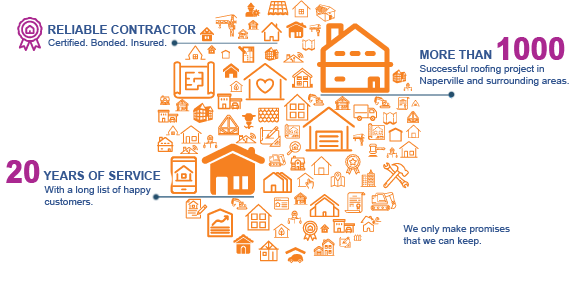
Common questions about hail damage from homeowners
Look at these questions and see how many you’re asking yourself right now. If your question isn’t addressed, contact your trusted local roofing and siding contractor and they should be able to answer your question for you. However, these are the most commonly asked in regard to hail damage:
How does hail damage the roof?
The granules on your shingles (assuming yours are asphalt) help to block UV rays while also protecting the underlying asphalt layer. Hail knocks off the granules, making the shingle susceptible to further damage.
What does hail damage look like?
Generally, damage will look like a bruise, or a dark spot. This is caused by the loss of granules and a depression in the shingle itself. In severe cases, the fiberglass mat will be exposed, making it obvious that the damage is severe.
Can I see hail damage from the ground?
Not usually. Severe storms might leave obvious damage that is viewable from the ground, but light hail with high winds can create damage that is only visible from an inspection upon the roof.
I have damage. Should I replace the roof immediately?
Because there is a statute of limitation regarding when you can make a claim following a storm, it’s smart to get to the bottom of it now instead of waiting. Furthermore, waiting only makes the problems worse.
Will the insurance company replace my roof?
Insurance is there to protect your property. The roof is an important component of your home, and if it’s damaged, everything under it is at risk, which is why it’s in the best interests of insurance companies to pay for these claims.
How long does it take from the time I file my claim to the time my roof is fixed?
That’s a tough one to answer because homes aren’t all the same, nor is the extent of the damage. However, if the adjustors and the contractors aren’t weighted down with other projects, it can take around two to three months from beginning to end. However, the actual roofing job itself is usually a one- or two-day project.
I have a new roof, so it should be covered by a warranty, right?
Wrong. Hail damage isn’t covered under manufacturers warranties.




